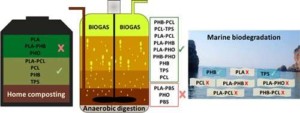
(c) American Chemical Society
Biodegradable polymers are often promoted as an environmental solution to plastic pollution. However, their degradation in managed and unmanaged environments is not always well understood. The authors of the study “Biodegradable plastic blends create new possibilities for end-of-life management of plastics but they are not a panacea for plastic pollution” investigate the fate of a range of biodegradable plastics and their blends under simulated controlled and uncontrolled environments. The objective is to better comprehend their potential environmental fate and end-of-life management options.
Polymers are ideal materials used in thousands of industrial and consumer products. However, the nature of oil-based plastic coupled with a throwaway culture results in negative environmental consequences. Furthermore, waste management lacks of effectivity in many countries. Some countries are singled out as major contributors to plastic pollution, while others have a landfill ban in place, and the recycling of plastics remains low globally.
In this context, biodegradable plastics are especially interesting for non-durable applications, such as packaging and agricultural films, where they offer new end-of-life management options not open to non-biodegradable plastics, e.g., composting and anaerobic digestion. Although human behaviour is a critical factor to prevent littering, biodegradability is also occasionally considered as an advantage when inadvertent environmental release occurs to aquatic and terrestrial environments.
However, these assumptions present an important challenge: The diversity of biodegradable materials and environments makes it difficult to make simple and generic assessments of their end-of-life fate.
In order to tackle this hurdle, the authors have tested neat polymers for biodegradation across seven managed and unmanaged environments: Polylactic acid (PLA), polyhydroxybutyrate (PHB), polyhydroxyoctanoate (PHO), polybutylene succinate (PBS), thermoplastic starch (TPS), polycaprolactone (PCL), and blends with characteristics suitable for packaging.
The study shows that PLA – one of the world’s best-selling biodegradable plastics – becomes home compostable when blended with PCL. Additionally, it also demonstrates that the majority of the tested bioplastics and their blends degrade by thermophilic anaerobic digestion with high biogas output, but degradation times are 3 to 6 times longer than the retention times in commercial plants. While some polymers and their blends (e.g. TPS, PHB) showed good biodegradation in soil and water, the majority of polymers and their blends tested in this study could not achieve applicable ISO and ASTM standards for these environments. However, all tested polymers and blends showed industrial compostability.
One of the drawn conclusions by the study is that biodegradable plastic blends need careful postconsumer management. Littering should not be accepted as an unfortunate but inevitable fact for any kind of waste, neither on land nor at sea – including all varieties of plastics. European Bioplastics considers a sound and well-functioning, source-separated waste collection as one of the essential measures to fight marine litter. All types of waste should find their way to appropriate and controlled forms of waste management and recycling.
The study was published in August 2018 and is available here.
Authors:
- Tanja Narancic
- Steven Verstichel
- Srinivasa Reddy Chaganti
- Laura Morales-Gamez
- Shane T. Kenny
- Bruno De Wilde
- Ramesh Babu Padamati
- Kevin E. O’Connor